Pool of Radiance: Ruins of Myth Drannor Updated Preview
We visit Mattel Interactive to track the progress of Pool of Radiance 2.
The latest build of Pool of Radiance: Ruins of Myth Drannor shows that the game's creators have made a great deal of progress on an already solid foundation for the game. Despite the fact that Ruins of Myth Drannor will feature detailed 3D graphics and TSR's new 3rd Edition Dungeons & Dragons rules, it will be a traditional computer role-playing game that's the spiritual successor to a true role-playing classic: the original Pool of Radiance. That's not just because the two games share the same title, either; both the original and the new Pool of Radiance games are developed by Stormfront Studios and published by SSI.
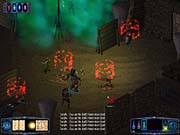
There have been many new features implemented into the current build of the game, including most of the game's lighting and special effects. This latest build features full day/night cycles, as well as spectacular effects for the game's many magic spells, which have also been implemented as per the 3rd Edition rules. For instance, as producer Jon Kromrey demonstrated, when the infamous magic-missile spell is cast by a high-level sorcerer, it can be used to attack multiple targets within a certain range. Some magic spells, like the eighth-level cleric spell fire storm, blanket the screen in billowing flames and showers of sparks. In addition, the game features lighting "halos" on characters that have been targeted by spells with persistent effects, like bless. These indicate not only what sort of spell has affected each character but also about how long it will last before it runs out.
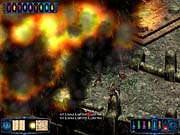
Ruins of Myth Drannor's character-generation system is also more or less complete, and it seems to be a streamlined and easy-to-use way to create 3rd Edition Dungeons & Dragons characters. Though you'll eventually have a party of up to six characters, you'll only be able to generate up to four at the beginning of the game. The remaining slots will be designated for allied nonplayer characters, which will become player characters under your control once they join the party. When generating your characters, you'll be able to choose from six of the 3rd Edition's seven character races (the seventh race, gnomes, wasn't implemented in the 3rd Edition Rules when Ruins of Myth Drannor began development, so it isn't included in the game). You'll also be able to choose from eight different character classes: the fighter, the ranger, the paladin, the barbarian, the monk, the sorcerer, the cleric, and the thief. Single-classed characters (those that don't join any other character classes) will be able to advance to 16th level; clerics and sorcerers will be able to attain spells of up to eighth level.
More on Character Creation
Ruins of Myth Drannor will feature the 3rd Edition rules' open-ended approach to "multiclass" characters - those assigned more than one profession. Instead of assigning multiple professions to a character when that character is first created, you'll be able to take any character that's attained second level or higher and assign that level to a different profession. For instance, if your first-level ranger gains a level, that character won't automatically become a level-two ranger; instead, you'll be able to assign that experience level either to the ranger class (which will make the character a level-two ranger) or to another character class, which will make that character first level in the ranger profession and first level in the alternate class. Characters that belong to multiple professions will be able to advance a total of 32 experience levels (a combined total of all their different professions). After you've chosen your character's race and class, you'll be able to determine your character's six ability scores (strength, dexterity, constitution, wisdom, intelligence, and charisma) using a set pool of attribute points rather than "rerolling" randomized ability scores until you get a set of high numbers.
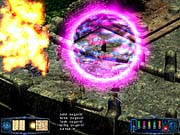
When you create your characters, you'll also need to choose their ethical alignment. Choosing a specific alignment won't exclude your party from taking part in certain quests; instead, it will affect how your character will interact with nonplayer characters, specifically, the sort of dialogue options that will be available. Your characters' alignment will also affect what sort of nonplayer characters will join your party during the course of the game.
You'll also be able to choose from various character models depending on your character's race. For instance, humans, elves, and half-elves will be able to choose from four male and four female character models. Each of these models has a fairly distinct look, and any changes made to any character's equipped items (including weapons and armor) will be reflected on the character model. For instance, bracers will appear on a character's arms under the robes he's wearing. And even the same types of weapons and armor will look different on each model. A suit of leather armor on a dwarf will look different than it does on a human or a halfling, which will help make a party of similarly equipped adventurers look different from one another. This sort of distinction will be especially important in the game's multiplayer component.
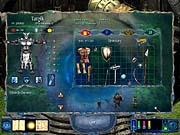
Ruins of Myth Drannor's multiplayer game will be more focused on hack-and-slash gameplay and the acquisition of magical treasure than the single-player game. Though you won't be able to play through the single-player game in multiplayer, you will be able to explore a number of randomly generated dungeons, each of which will be huge and each of which will be full of bloodthirsty monsters and lots of riches. The difficulty of these dungeons and the relative power of the enemies you'll face will be scaled according to your characters' levels. Low-level characters might face a small squadron of stupid, disorganized goblins and orcs, while a higher-level party in the same dungeon might face a more organized group of wolf-riding goblins and orc shaman. While hacking through these dungeons, your characters will find not only generic magical treasure but also class-specific items. A monk might find a magical monk's bo staff, for instance.
Exploring Myth Drannor
The game's single-player component will include more exploration and quest solving than the multiplayer component; though your party will begin in the city of New Phlan, it'll spend most of the game in the titular ruins. As the party members fight monsters and capture enemy weapons, armor, and caches of gold, they'll be able to trade with Nottle, a halfling nonplayer character who actually scavenges items in their wake and will trade with them throughout the game. Your characters will meet other notable individuals, including established and well-known Forgotten Realms characters and characters from the game's companion novel, which shares the game's title. They'll also fight well-known Dungeons & Dragons enemies, such as orcs and goblins, as well as more exotic enemies, such as the four-armed sluglike ormyrr. In addition, your characters will do battle with the half-lion, half-scorpion arracat, a completely original monster of Stormfront Studios' creation that will be included in future Dungeons & Dragons rulebooks.
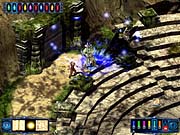
Regardless of whether your party is fighting or exploring, it'll be aided by the game's utilitarian interface, which has many useful options, both in combat and out. In combat, you'll be able to quickly and easily tell the limit of your characters' movements, as well as how far they can move without sacrificing the ability to make an attack or cast a spell. In addition, the game will also clearly indicate which enemies (and allies) are in range of any magic spells or ranged weapons you intend to use. And clever adventurers will be able to exploit the game's terrain - the height advantage has been fully implemented into Ruins of Myth Drannor, so cagey adventurers will position their characters atop stairways and balconies to gain additional combat bonuses.
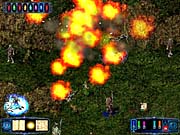
Out of combat, you'll find that Ruins of Myth Drannor has a number of other handy and commonsensical interface options, like its inventory system, which isn't based on a set number of inventory slots, but rather on a character's strength rating (so a powerful half-orc would be able to carry several times what a halfling would). In addition, the game has an automap feature that not only lets you mark specific locations with your own notes but also lets you zoom in and out to get a better look at an area. The game's interface will also clearly show whether it's safe to rest in a particular location - an indicator will change colors to show whether an area is safe, unsafe, or uncertain. In an uncertain area, your party may be ambushed while it rests.
Pool of Radiance: Ruins of Myth Drannor is still currently scheduled for release this Christmas. The game will be available both as a standard edition and as a collector's edition, which will include among other things a miniature character figurine, the companion novel, the companion Dungeons & Dragons module (should you want to run the game as a pencil-and-paper campaign), and dice.
Got a news tip or want to contact us directly? Email news@gamespot.com
Join the conversation